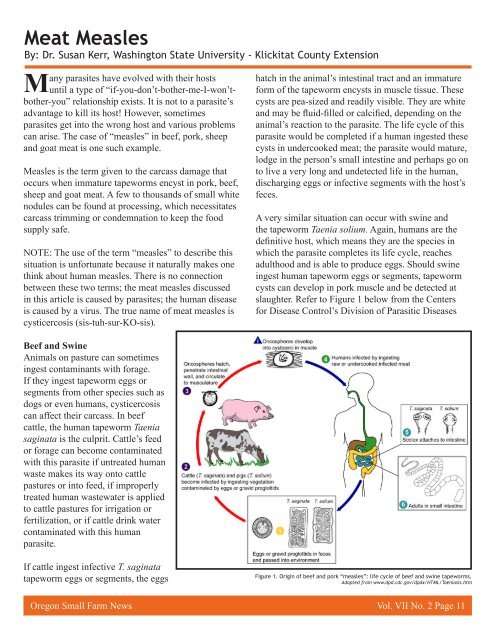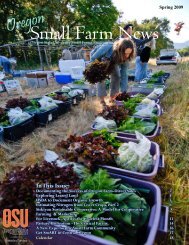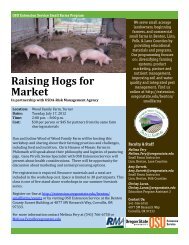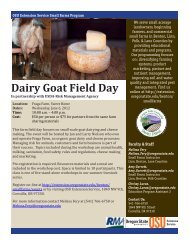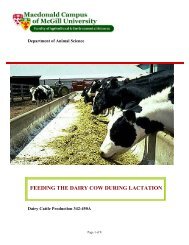Small Farm News - Oregon Small Farms - Oregon State University
Small Farm News - Oregon Small Farms - Oregon State University
Small Farm News - Oregon Small Farms - Oregon State University
Create successful ePaper yourself
Turn your PDF publications into a flip-book with our unique Google optimized e-Paper software.
Meat Measles<br />
By: Dr. Susan Kerr, Washington <strong>State</strong> <strong>University</strong> - Klickitat County Extension<br />
Many parasites have evolved with their hosts<br />
until a type of “if-you-don’t-bother-me-I-won’tbother-you”<br />
relationship exists. It is not to a parasite’s<br />
advantage to kill its host! However, sometimes<br />
parasites get into the wrong host and various problems<br />
can arise. The case of “measles” in beef, pork, sheep<br />
and goat meat is one such example.<br />
Measles is the term given to the carcass damage that<br />
occurs when immature tapeworms encyst in pork, beef,<br />
sheep and goat meat. A few to thousands of small white<br />
nodules can be found at processing, which necessitates<br />
carcass trimming or condemnation to keep the food<br />
supply safe.<br />
NOTE: The use of the term “measles” to describe this<br />
situation is unfortunate because it naturally makes one<br />
think about human measles. There is no connection<br />
between these two terms; the meat measles discussed<br />
in this article is caused by parasites; the human disease<br />
is caused by a virus. The true name of meat measles is<br />
cysticercosis (sis-tuh-sur-KO-sis).<br />
Beef and Swine<br />
Animals on pasture can sometimes<br />
ingest contaminants with forage.<br />
If they ingest tapeworm eggs or<br />
segments from other species such as<br />
dogs or even humans, cysticercosis<br />
can affect their carcass. In beef<br />
cattle, the human tapeworm Taenia<br />
saginata is the culprit. Cattle’s feed<br />
or forage can become contaminated<br />
with this parasite if untreated human<br />
waste makes its way onto cattle<br />
pastures or into feed, if improperly<br />
treated human wastewater is applied<br />
to cattle pastures for irrigation or<br />
fertilization, or if cattle drink water<br />
contaminated with this human<br />
parasite.<br />
If cattle ingest infective T. saginata<br />
tapeworm eggs or segments, the eggs<br />
hatch in the animal’s intestinal tract and an immature<br />
form of the tapeworm encysts in muscle tissue. These<br />
cysts are pea-sized and readily visible. They are white<br />
and may be fluid-filled or calcified, depending on the<br />
animal’s reaction to the parasite. The life cycle of this<br />
parasite would be completed if a human ingested these<br />
cysts in undercooked meat; the parasite would mature,<br />
lodge in the person’s small intestine and perhaps go on<br />
to live a very long and undetected life in the human,<br />
discharging eggs or infective segments with the host’s<br />
feces.<br />
A very similar situation can occur with swine and<br />
the tapeworm Taenia solium. Again, humans are the<br />
definitive host, which means they are the species in<br />
which the parasite completes its life cycle, reaches<br />
adulthood and is able to produce eggs. Should swine<br />
ingest human tapeworm eggs or segments, tapeworm<br />
cysts can develop in pork muscle and be detected at<br />
slaughter. Refer to Figure 1 below from the Centers<br />
for Disease Control’s Division of Parasitic Diseases<br />
Figure 1. Origin of beef and pork “measles”: life cycle of beef and swine tapeworms.<br />
Adapted from www.dpd.cdc.gov/dpdx/HTML/Taeniasis.htm<br />
<strong>Oregon</strong> <strong>Small</strong> <strong>Farm</strong> <strong>News</strong> Vol. VII No. 2 Page 11


